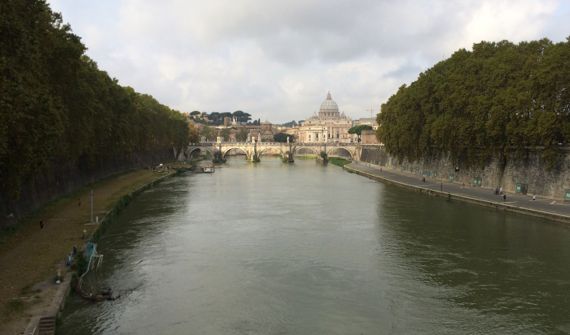
We’re in a phase of ordering frizzante, bottled mineral water with bubbles, with our meals. It’s not always Pellegrino, but I have noticed that two times the bottle held 92, and today’s restaurant served us a 75. (I think the units are decilitres/deciliters.)
Haha, we probably even paid more for the 75.
And umph years ago, all the restaurants would have been serving full liter bottles!
Posted at 2:43 PM |
Comments Off on Details, details

Yeah, it’s Sunday, and this is Rome, so we left the city for a foreign country, arriving, oh darn, just in time to mingle with the departing crowds*—except for those in the long line looped all the way around the Piazza San Pietro, and then some. LONG line (to enter St. Peter’s). We walked through the shady south side of the Piazza, then back out into the southeast corner of the Vatican proper. I knew when we entered the Vatican, but not when we left. (Fuzzy, permeable boundaries in both cases, in my archaeo-analysis terms.)
I like this shot down the river at St. Peter’s because of the sunken ship/barge in the lower left. Moored, abandoned, sunken. Is this a comment on the future of the Catholic Church????

Worship can take many forms. This pair of statue nubbins was a favorite of a tailor named Pasquino. He would attach his satirical and anonymous comments about the church bureaucracy and whatever to the pedestal with great frequency. In some versions he was a barber, but whatever—he worked in the Vatican (or not) and overheard plenty of gossip.
The battered sculpture was found buried during road construction in 1501. (Some) art historians think it is of Helen of Troy’s husband, Menelaus, holding the body of Achille’s buddy Petroclus. This is interesting because in later tellings, Petroclus was an unsuccessful suitor of Helen’s, and Helen of course picked up with Paris at some point, although Menelaus took her back. Triangles and triangles.
The statue and Pasquino…. The tradition of posting anonymous acerbic comments on this and several other statues lead to them being called Talking Statues. This one came to be called Pasquino, naturally. In this time it was customary to post screeds and announcements on public walls, a tradition that continues in some form today. We use the word pasquinade for the posting of lampoons and similar. Anonymity was different prior to the internet….
*…which probably would have been far larger except that the Pope was in Albania today.
Posted at 9:29 AM |
Comments Off on No “Meet the Press”


